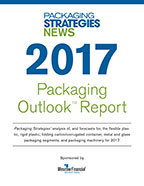Editor's Note | Brad Addington
The Mergers & Acquisitions Outlook for 2024
I recently turned to two experts to help me make sense of the significant pace of consolidation within the packaging industry.

Image Source: Feodora Chiosea/iStock via Getty Images
At Packaging Strategies, we write regularly about mergers and acquisitions. However, for some time I’ve wanted to pull back and get a wide-angle shot of the M&A landscape.
I was recently afforded this 5,000-foot view via a discussion with Thomas Blaige, founder, chair, and CEO of Blaige Industry Analytics LLC, and Ron Giordano, a senior executive adviser at Blaige, which is an active member of the Flexible Packaging Association (FPA).
Blaige had been quoted back in October as saying he viewed the label converting sector as ripe for consolidation, so I asked him if the same could be said for other areas of converting. As part of his answer, he cited this table from his company’s 2024 M&A Outlook Report. The answer is clearly in the affirmative, with an impressive amount of consolidation also witnessed in such areas as injection molding, blow molding/rotational molding, flexible packaging and thermoforming.
“Since 2001, 78% of the top 50 companies in each of the six plastics and packaging segments analyzed in this report have been either eliminated or undergone changes in ownership,” the report notes. “Specifically, 60% of these companies have been eliminated through consolidation, while 18% have sold a controlling interest while retaining their corporate identities. ... Notably, the molding and flexible packaging segments have witnessed the highest level of consolidation, with significant mergers and acquisitions activity over the past two decades.”
While packaging M&A took a bit of a downturn in 2023, Blaige and Giordano say they expect M&A activity to rebound in 2024. They said some factors behind that continued activity include:
- The highly fragmented nature of post-World War II industries such as flexible packaging, rigid packaging and narrow and wide web flexo printing, which are much less consolidated than the metal, glass and fiber industries. “You’ve got hundreds to thousands of players in each segment,” Blaige noted.
- No Succession Plan. “The entrepreneurs are aging. The second and third generations don’t want to be in packaging,” Blaige said. “There is a succession crisis that is evolving that was not significant before.”
- Bigger is Better. It’s simply easier for big companies to compete than small companies, especially in light of significant packaging challenges that need to be addressed. For example, the current tremendous strains on foil packaging markets – which stem largely from continued tariffs and new duties on imported converter-grade aluminum foil from China, South Korea and Thailand – could motivate a company to develop a non-foil lid that has all the positive attributes of a foil lid. Only bigger firms would have that capability.
Bottom Line: My recent discussion with Blaige and Giordano was highly insightful, and I plan to turn to them time and again during 2024 to provide valuable context and perspective to the numerous mergers and acquisition that are sure to come down the pike this year.
Brad Addington
Chief Editor, Packaging Strategies
(248) 227-4727
addingtonb@bnpmedia.com
Looking for a reprint of this article?
From high-res PDFs to custom plaques, order your copy today!







